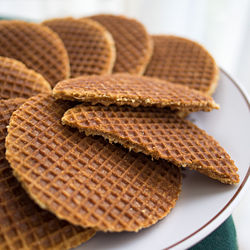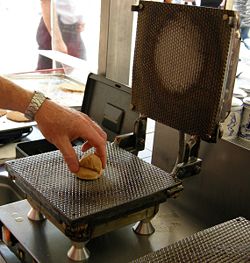 A plate of stroopwafels | |
| Alternative names | Syrup waffle, treacle waffle, caramel waffle [1] |
|---|---|
| Type | Waffle |
| Place of origin | South Holland |
| Created by | Gerard Kamphuisen [2] |
| Main ingredients | Batter: flour, butter, brown sugar, yeast, milk, eggs Filling: syrup, brown sugar, butter, cinnamon |
A stroopwafel (Dutch pronunciation: [ˈstroːpˌʋaːfəl] ⓘ ; lit. 'syrup waffle') is a thin, round biscuit made from two layers of sweet baked dough held together by syrup filling. [3] [4] First made in the city of Gouda in South Holland, stroopwafels are a well-known Dutch treat popular throughout the Netherlands.



